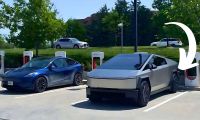With more than 40 states now easing their lockdowns that have kept so much of the nation off the road for the last two months, many people are finding a need to get their F-150s, hybrids, and EVs back on the road.
Ford F-150s Easy To Get On Road
Now, getting an F-150 or hybrid back on the road is easy. Since F-150s are primarily gasoline-powered, it should be easy to get them ready for the road. All you have to do is turn their engines over, if there is still a charge in the battery and fuel in the tank, the vehicles should startup, and you're on your way.
If you own an electric vehicle (EV) or hybrid, you may have problems if you haven't driven it for some time. Remember, some states have been on lockdown for more than two months.
During that shutdown, driving was limited. Some lockdowns limited you to driving only to the market or drugstore, neither of which are likely to have charging stations now. So you may have a huge problem with your EV or hybrid unless you had access to a home charger line or circuit.
In the future, this is likely to be a smaller problem as the buildout of charger networks are moving ahead around the nation.
Torque News Senior Reporter John Goreham also shares his views on advice that will let you re-open your vehicle.
If your EV likely hasn't moved much due to the COVID-19 crisis, you may have a few questions or other issues facing you when you try to move your vehicle.
Ford EVs Need Battery Charge
For example, owners of battery-powered vehicles may wonder how much charge they need to keep in their vehicle batteries in shape, while others may wonder whether the batteries will become depleted if the EV isn't used. The batteries are left uncharged for a time.
To bring you some reliable information about EVs and batteries, Ford made its battery expert Bob Taenaka, senior technical leader, Battery and Cell System Development, available to provide some tips on how to keep an EV in top condition if you are still facing a bit of time in lockdown or self-isolation.
The key, Taenaka, said, is to make sure your 12-volt battery stays charged and that the high-voltage battery has an adequate charge – 10 percent or more – to keep it from draining to zero.
Let's say you have driven your EV recently, or had your vehicle on a charger for at least eight hours in the last month. Then the 12-volt battery should be all set.
Ford Has Some Tips For Storage
For longer periods between trips, you should take these steps:
- Consult your owner's manual for specific instructions on Vehicle Storage for longer than 30 days.
- If you are storing your EV without plugging it in, Taenaka urges you to keep the state of charge between 10 percent and 80 percent.
- Consult your vehicle's owner's manual about storage for longer than 30 days.
- If you are storing your hybrid or plug-in hybrid vehicle without plugging it in, you should keep the state of charge between 10 and 80 percent. Like EVs, hybrids are designed to stay above 10 percent charge during normal operation.
Note
If there may be longer periods of down-time, do the following:
Ford Hybrids Need 10 Volts
According to Ford, a high-voltage battery – with a 10 percent state of charge – can go for more than six months without charge. However, when the 12-volt battery is connected to a vehicle, it will drain much faster.
Taenaka had the following recommendations if you don't plan driving for a month or more.
A high-voltage battery above 10 percent state of charge can go for more than six months without charging, but the 12-volt battery will drain much faster, especially, when connected to the vehicle. If you do not plan to drive your electrified vehicle for longer than 30 days, Taenaka recommends following these steps for the sake of your 12-volt battery:
- Disconnect the negative terminal of the 12-volt battery (only if you are familiar and comfortable doing so).
- Or, you can connect the 12-volt battery to a standard battery charger and leave it on a continuous slow charge.
Ford Advises You To Disconnect Terminal
"if you are storing your vehicle for longer than 30 days without use, we recommend disconnecting the negative terminal of your 12-volt battery. This avoids depletion and potential damage to the battery, which runs the internal systems such as heating – without the need for maintenance," Taenaka emphasized.
He also had some other recommendations if you are planning for long-term storage. They include:
- Be sure to have your key fob and digital owner's manual with you outside the vehicle because you may need to use the physical key (inside the fob) to lock and unlock the vehicle. You can easily store the digital owner's manual on your smartphone or tablet. The manual is a handy reference.
- If your vehicle is in a locked garage and the 12-volt battery is in the trunk, leave the trunk open.
- Once your vehicle's 12-volt power disconnected, you can use the physical key to lock and unlock your vehicle.
- If your 12-volt battery is in the trunk, but you are not storing the vehicle in a locked garage, you will need another 12-volt power source. Follow the jump start instructions in the owner’s manual to restore 12-volt power to the vehicle in order to reopen the trunk.
Ford Advises Taking Key Fob
Ford Has Warm Weather Advice
With warmer temperatures on the way, your vehicle and its batteries are designed to handle long-term storage outside in the direct sunlight. Taenaka said that if you are experiencing extremely hot weather and the vehicle needs to be stored for more than 30 days store your vehicle in a garage or in the shade to preserve battery capacity and extend its lifespan if it is practical to do so.
For more information, refer to the owner's manual for details about storing your vehicle and removing it from storage.
Marc Stern has been an auto writer since 1971. It was a position that filled two boyhood dreams: One was that I would write, and two that I write about cars. When I took over as my newspaper's auto editor, I began a 32-year career as an automotive columnist. There isn't much on four wheels that I haven't driven or reviewed. My work has appeared in Popular Mechanics, Mechanix Illustrated, AutoWeek, SuperStock, Trailer Life, Old Cars Weekly, Special Interest Autos, and others. Today, I am the Ford F150 reporter for Torque News. I write how-to and help columns for online sites such as Fixya.com and others. You can follow me on Twitter or Facebook. Most of Marc's stories can be found at Torque News Ford coverage. Check back again and search for Torque News Ford F-150 news for more F-150 truck news coverage.












